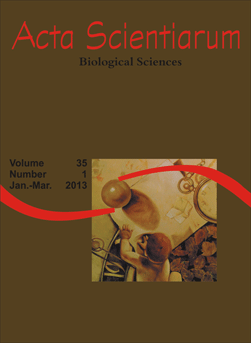<b>Morphological aspects of the salivary glands of Crab-eating racoon (<i>Procyon cancrivorus</i>)</b> - doi: 10.4025/actascibiolsci.v35i1.12675
Abstract
Procyon cancrivorus is a wild mammal from the Procyonidae family, being one of the least studied Brazilian carnivores. The aim of this study was to describe the morphological aspects of the salivary glands of Procyon cancrivorus, and to compare with literature data on the morphology of domestic animals and wilds animals, such as coatis and possums. Three adult animals were collected on highways (roadkilled), fixed 10% formaldehyde aqueous solution and submitted to desiccation. The salivary glands of the crab-eating raccoon are formed by the parotid, mandibular, sublingual and zygomatic glands. The parotid gland shows irregularly triangular shape with its respective duct. The mandible gland shows rounded outline surrounded by a fibrous capsule with its respective duct. The sublingual gland is divided into two parts: the caudal part, located in the occiptomandibular region of the digastric muscle and the rostral part between the tunica mucosa of the mouth and the mylohyoid muscle with its respective duct. The zygomatic gland is small and rounded, located in the rostral part of the pterygopalatine fossa with its respective duct. The morphology of the salivary glands of crab-eating raccoon presents great similarity in shape and arrangement with the glands of dog, cat, coatis and possum.
Downloads
DECLARATION OF ORIGINALITY AND COPYRIGHTS
I Declare that current article is original and has not been submitted for publication, in part or in whole, to any other national or international journal.
The copyrights belong exclusively to the authors. Published content is licensed under Creative Commons Attribution 4.0 (CC BY 4.0) guidelines, which allows sharing (copy and distribution of the material in any medium or format) and adaptation (remix, transform, and build upon the material) for any purpose, even commercially, under the terms of attribution.
Read this link for further information on how to use CC BY 4.0 properly.












1.png)




3.png)













